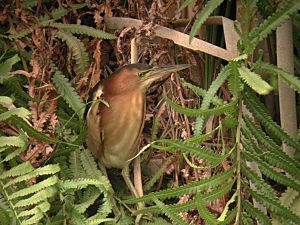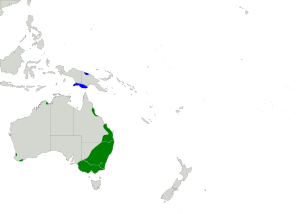Black-backed bittern facts for kids
Quick facts for kids Black-backed bittern |
|
|---|---|
 |
|
| Black-backed bittern (adult male) | |
| Conservation status | |
| Scientific classification | |
| Genus: |
Ixobrychus
|
| Species: |
dubius
|
 |
|
| Synonyms | |
|
|
The black-backed bittern (Ixobrychus dubius) is a shy and rarely seen bird. It's also called the black-backed least bittern or Australian little bittern. This small bird belongs to the heron family and lives in Australia. Sometimes, it can also be found in southern New Guinea.
This bird was once thought to be the same as the little bittern. However, scientists now know it is its own unique species. It is one of the smallest herons in the world.
Contents
What is a Black-backed Bittern?
This tiny bird is usually about 25 to 36 centimeters (10 to 14 inches) long. It weighs between 60 and 120 grams (2 to 4 ounces). That's about the weight of a small apple!
Appearance of the Bittern
Adult male bitterns have mostly black feathers on their upper body. This includes a black cap on their head. Their chest, neck, and sides of the head are a rich reddish-brown color. When they fly, you can see large, light brown patches on their shoulders.
Female bitterns are a bit duller in color. Their back and head are brown and streaky. Young birds look similar to the females. The eyes of the bittern are yellow. Their beak is yellow with a black top part. Their feet and legs are a greenish-yellow color.
Where Do Black-backed Bitterns Live?
Black-backed bitterns are found in different parts of Australia. Most sightings are in the southeast, especially around the Murray-Darling Basin. They are also seen along the east coast. In southwest Western Australia, they are common in the Swan Coastal Plain.
Sometimes, these birds are spotted in other areas. This includes coastal parts of the Kimberley region and the Torres Strait islands. Very rarely, they might even fly to Lord Howe Island or New Zealand.
Seasonal Journeys
It seems that some black-backed bitterns travel long distances. In southern Australia, they are mostly seen in spring and summer. They are largely absent during autumn and winter. This suggests they might move to warmer areas during the colder months. There are not many records of them breeding in Australia's tropical areas.
Bitterns in New Guinea
In New Guinea, these birds are found seasonally in the Waigani Swamp near Port Moresby. They are usually there from November to April. They have also been seen in the lowlands of the Trans-Fly region.
There are no clear records of them breeding in New Guinea. However, one bird found there seemed ready to lay eggs. This suggests they might breed in the Fly River marshes in September. The lack of breeding records means some birds in New Guinea might be seasonal visitors from Australia.
Bitterns in New Caledonia
A black-backed bittern was seen in New Caledonia in 2001. It even bred there, which was an exciting discovery!
What is Their Home Like?
Black-backed bitterns mostly live in freshwater wetlands. These are places where the land is covered with water, like swamps. They prefer areas with thick plants growing out of the water, such as reeds and sedges. They also like flooded bushes.
Sometimes, they can be found in salty or slightly salty wetlands. This includes mangrove swamps and salt marshes. They might also live at the edges of coastal lagoons that have trees.
How Do Black-backed Bitterns Behave?
Black-backed bitterns are usually alone and very secretive. They are hard to spot and are mostly active at dusk or at night. They like to hide in reed beds. They walk in a crouched position, with their head stretched forward. If they need to cross open ground, they do it very quickly. They sneak up on their prey at the water's edge.
When they feel scared, they stand very still. They point their head and beak straight up into the sky. This helps them blend in with the tall reeds. They usually don't like to fly. If they are forced to fly, they keep their head pulled back. Their legs dangle as they skim low over the water and plants.
Breeding Habits
These bitterns breed in spring and early summer. They usually nest in single pairs. Sometimes, they might form small groups, with nests about 15 to 30 meters (50 to 100 feet) apart. They build their nests in thick wetland plants.
The nest is a platform made of reeds and other plant material. It's about 15 to 20 centimeters (6 to 8 inches) wide and 10 centimeters (4 inches) thick. The nest is always built over water and supported by tall, growing reeds. It also has cover overhead to keep it hidden.
A female bittern usually lays four to six plain white eggs. The eggs hatch after about 21 days. The baby chicks are covered in soft, orange-brown downy feathers. Both parents feed the chicks by bringing up food from their stomachs. Young birds can start climbing in the reeds when they are 9 to 10 days old. They take their first flight when they are 25 to 30 days old. They stay with their parents for at least another 14 days after that.
What Do They Eat?
Black-backed bitterns mainly eat small water animals without backbones. This includes crustaceans like tiny crabs or shrimp. They also eat dragonfly larvae, which are young dragonflies. Sometimes, they eat small animals with backbones, like fish and frogs.
They hunt by waiting quietly for their prey to come close enough. Then, they quickly grab it with their beak. They also actively stalk their prey, moving slowly and carefully.
Their Voice
Not much is known about the sounds black-backed bitterns make. Outside of breeding season, they are usually silent. They might make some low croaking or grunting sounds. During breeding season, the males make a deep, low, and steady croaking call. They repeat this call every half-second to attract a mate.
Protecting the Black-backed Bittern
In Australia, black-backed bitterns are listed as "Near Threatened." This means they could become endangered in the future. In the state of Victoria, they are listed as "Endangered."
Scientists believe there are about 5,000 adult black-backed bitterns in the world. Most of them live in Australia. More than 1,000 of these birds live in southwest Western Australia.
Threats to Their Survival
These birds face several dangers. Their wetland homes are being damaged. This happens because of things like:
- Salt getting into freshwater areas.
- Draining wetlands for other uses.
- Taking water away for farming.
- Fires that burn their nesting areas at the wrong time.
Protecting wetlands is very important to help these unique birds survive.
See also
 In Spanish: Avetorillo australiano para niños
In Spanish: Avetorillo australiano para niños


